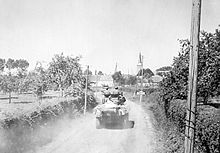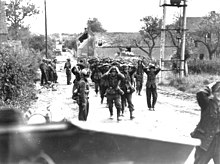Falaise cauldron
| date | August 12. bis 21st August 1944 |
|---|---|
| place | Normandy , France |
| output | Allied victory |
| Parties to the conflict | |
|---|---|
|
|
|
| Commander | |
|
|
|
| Troop strength | |
| 350,000 | 150,000 |
| losses | |
|
~ 6000 fallen |
~ 12,000 fallen |
A battle in World War II between the Western Allied forces and the German Wehrmacht is called the Falaise Pocket .
After the successful D-Day and the breach of the German lines in the course of Operation Cobra , the Kesselschlacht near Falaise broke out south of Caen in early August 1944 .
background
The Allied landing in Normandy had set up a second front in Western Europe , but German Wehrmacht units were opposed to a further Allied advance and formed a barrier around the bridgehead. After the success of Operation Cobra , which led to the outbreak of the 3rd US Army on the Atlantic Ocean near Brittany in the west , the Americans under the command of Bradley and the commanding General Patton managed to move the German 7th Army into their rear with the left wing to include. At the east end of the landing head, the British and Canadians under Montgomery tried to seal off the Falaise basin from Caen .
Starting position
Due to the Fiihrer's order not to back down at any price, the German troops were bypassed almost unhindered by Patton's units on their open southern flank. With Operation Totalize , Montgomery launched another attack against the German units near Caen . This brought two British armored divisions far enough forward to threaten the rear of the German lines. As a result of this approach, 28 infantry divisions and eleven tank divisions of the Germans were in danger of being pinched by the Allies.
After Operation Liège , the counterattack at Mortain , aimed at cutting off the neck of the bottle at the breakout point of the Americans at Avranches , was broken off , the 5th German Panzer Army received orders to attack in a south-westerly direction. This exposed them to the risk of being trapped between Falaise and Argentan by the Allied forces.
In reference to Hitler's order, the war diary of the commanding Field Marshal von Kluge states:
"Incredibility of a large military force [...] planning an attack in peace, while the enemy is busily forming a noose far behind to strangle them."
The boiler
On August 8, Patton's 5th Armored Division reached Le Mans, where it joined forces with the French 2nd Armored Division under Leclerc . Bradley and Montgomery agreed on the same day to enclose the German army west of the Seine . Patton's two tank divisions should therefore turn north from Le Mans to form a merger with Montgomery's divisions, which were to turn in a south-easterly direction from Caen. Pattons XV Corps then swiveled at a right angle towards Argentan , while its other divisions advanced to the Seine. This enabled Bradley to create a short hook as well as a long one. The long hook made it possible to intercept the German troops escaping from Falaise.
On August 16, the German troops received Hitler's orders to withdraw in three phases:
- First all troops west of the Orne should withdraw,
- then cross the dives with all troops, and
- finally cross the Seine with all troops.
The II. SS Panzer Corps was supposed to hold the area east of Falaise in order to ensure an escape from the pocket as long as possible. This order came almost too late, because the crossing of three small rivers had little chance of success during the day under fire due to Allied air superiority .
But Bradley had Patton's XV. Corps ordered to hold north of Argentan. He feared collisions with British units advancing from the north. This resulted in a 25 km wide gap through which the German troops tried to escape. In particular, parts of the 12th SS Panzer Division "Hitler Youth" and the 1st Canadian Army fought fierce battles over several days. After that, the 1st Polish Armored Division and the 90th US Infantry Division almost closed the pocket near Chambois on August 19 .
The 1st Polish Panzer Division was able to repel counterattacks by the 2nd and 9th SS Panzer Divisions on Mont Ormel until August 21, but this left a crack in the bolt open to the very end. Nevertheless, between August 18 and 21, the basin shrank to form an eight-kilometer-wide strip which, in addition to the numerous air raids, was shot at with up to 80,000 shells every day. On September 1st the battle ended with the last retreating soldiers.
The German commander Walter Model , who was substituted on August 16 as the new Commander-in-Chief West , succeeded through rigorous intervention without taking Hitler's ideas into account to get combat-ready units out of the basin and then over the Seine at Elbeuf .
losses
The German Wehrmacht lost a total of 50,000 soldiers (dead, wounded and missing) in the west between August 7 and 21; another 200,000 were taken prisoner of war. Up to this point the German losses in Normandy amounted to more than 240,000 dead or wounded and 250,000 prisoners. The Wehrmacht lost 1,500 tanks, 3,500 guns and 20,000 other vehicles in terms of material.
The Allies put their casualties during Operation Overlord at 209,672, including 36,976 dead.
With their victory at Falaise, the Allied forces were then able to advance towards the Seine and eventually Paris .
Consequences and evaluation
The Wehrmacht did not recover from the material losses suffered in the Falaise pocket. According to official information, about 20,000 to 30,000 soldiers escaped from the boiler, but they only had 25 tanks and 50 self-propelled guns ; in addition, tens of thousands of soldiers lost their equipment. The Allies reached Paris on August 25 and liberated all of France before the end of the year, with the exception of a few Atlantic ports, some of which were held by the Germans until the end of the war.
Allied commanders themselves delayed the advance several times and failed to completely close the pocket earlier. Antony Beevor attributes "Lethargy and incompetence" to the commander of the 4th Canadian (Armored) Division , Major General George Kitching. The fact that the complete annihilation of the German armies ultimately did not succeed was mainly due to Montgomery, who was already criticized by the other commanders at that time. Americans and the RAF were even more angry about his premature announcements and his complacency immediately afterwards. However, the Americans had also stood behind Argentan with their southern pincers for a day - whether on Bradley's instructions or because Patton wanted to lead the two tank divisions directly to Paris is unclear.
literature
- Ken Ford: Falaise 1944. Death of an army (Campaign). Osprey Publishing, 2005, ISBN 1841766267 .
- Denis Whitaker, Shelagh Whitaker, Terry Copp: Falaise. The Allied Victory in Normandy. HarperCollins Publishers, 2000, ISBN 0002000172 .
- Martin Blumenson: The Battle of the Generals. The Untold Story of the Falaise Pocket - The Campaign That Should Have Won World War II. William Morrow & Co., 1993, ISBN 0688118372 .
- William B. Breuer: Death of a Nazi Army. The Falaise Pocket. Stein & Day Pub., 1985, ISBN 0812830245 .
- Dieter Ose: Decision in the West. Deutsche Verlags-Anstalt, Stuttgart 1982, ISBN 3-421-01998-3 .
- Antony Beevor: D-Day. The battle for Normandy. Bertelsmann, Munich 2010, ISBN 978-3-570-10007-3 .
Web links
- Stephen A Hart et al .: The Final Battle for Normandy. Northern France, July 9 - August 30, 1944. In: Second World War 60th Anniversary. 2005, accessed February 25, 2015 . (Page 13)




